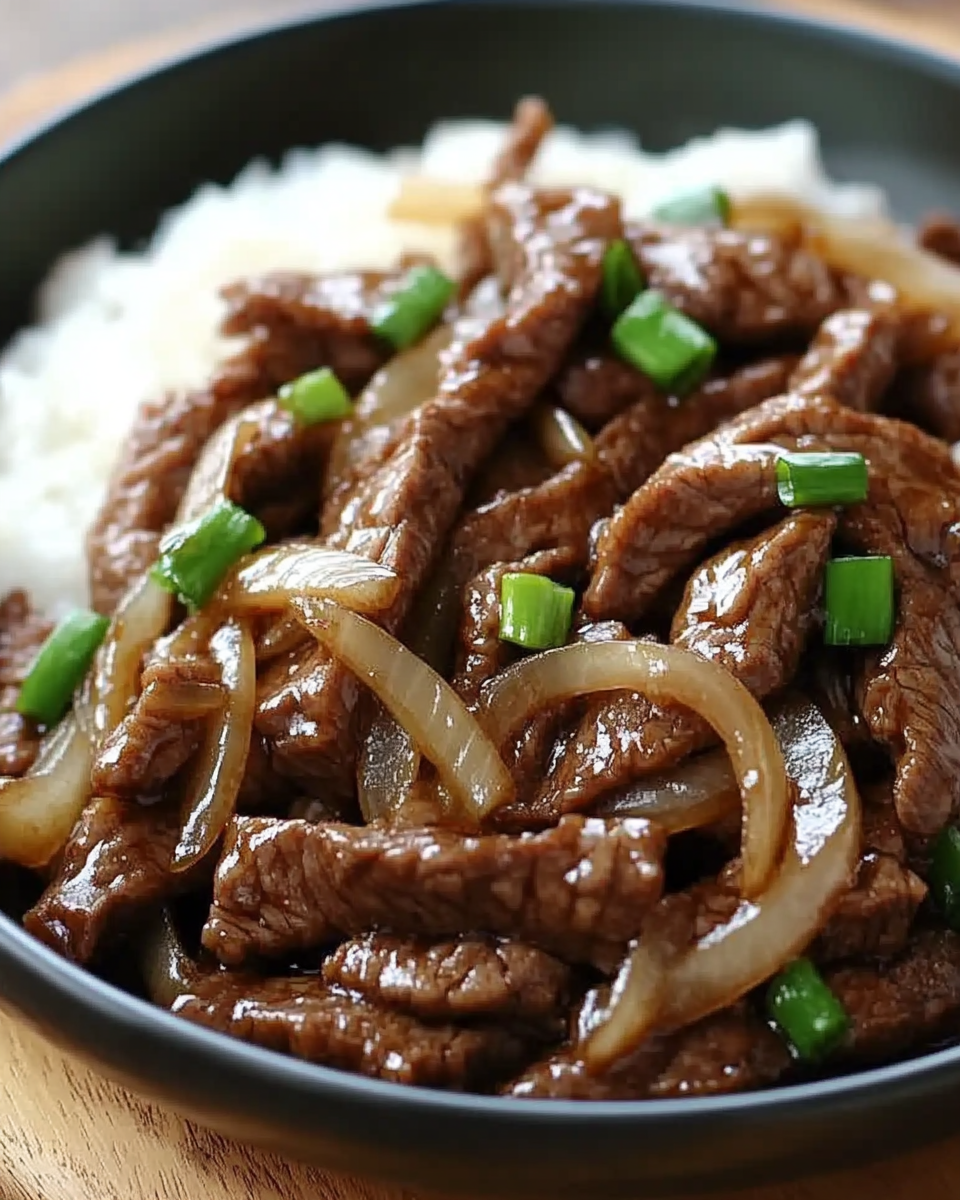This Chinese Beef and Onion Stir Fry is a perfect quick and flavorful weeknight meal ready in under 30 minutes. Tender strips of beef are stir-fried with aromatic ginger, garlic, and sweet onions, combined with a savory sauce made from soy, oyster, hoisin sauces, and rice vinegar. It pairs beautifully with steamed rice or noodles for a satisfying, restaurant-quality dinner at home.
Full Recipe:
Ingredients
-
300 g sirloin steak (or rib-eye, flank steak, or blade steak)
-
½ white onion (or yellow onion), thinly sliced
-
4-5 slices ginger
-
3 cloves garlic, minced or sliced thinly
-
1 stalk green onion, cut into 2-inch pieces
-
2 tablespoons soy sauce
-
1 tablespoon oyster sauce
-
1 tablespoon hoisin sauce
-
1 tablespoon rice vinegar
-
1 teaspoon sugar
-
1 tablespoon cornstarch (optional, for thickening)
-
2 tablespoons vegetable oil (for stir-frying)
Directions
-
Slice the beef thinly against the grain and set aside.
-
Whisk together soy sauce, oyster sauce, hoisin sauce, rice vinegar, and sugar in a small bowl. Set aside.
-
Heat 1 tablespoon oil in a skillet or wok over medium-high heat. Add ginger slices and cook until fragrant (about 1 minute). Add garlic and cook 30 seconds more.
-
Add beef and stir-fry for 3-5 minutes until browned and cooked through.
-
Push beef to one side, add remaining oil, and sauté onions for 2-3 minutes until they soften.
-
Add green onions and cook another minute. Pour sauce over beef and onions, stirring to coat.
-
(Optional) Dissolve cornstarch in 1 tablespoon water and stir into sauce. Simmer 1-2 minutes to thicken.
-
Serve hot with steamed rice or noodles.
Nutrients (per serving, serves 2)
-
Calories: 300 kcal
-
Protein: Approx. 25-30 g
-
Carbohydrates: 8-10 g
-
Fat: 12-15 g
-
Sodium: Moderate (from soy and oyster sauce)
Why This Dish Works So Well
The beauty of this stir fry lies in its simplicity and balance. Each ingredient plays a distinct role: the beef provides rich umami and protein, the onions bring natural sweetness and texture, and the ginger and garlic add fragrant warmth that lifts the entire dish. The sauce, made from soy, oyster, hoisin sauces, and rice vinegar, contributes layers of complexity—salty, tangy, slightly sweet, and savory all at once.
Cooking the beef quickly over high heat ensures it remains tender and juicy, while the onions soften just enough to retain a bit of crunch and sweetness. The green onions, added towards the end, add freshness and a mild sharpness that brightens the dish. This harmony of flavors and textures makes it easy to enjoy as a comforting yet light meal.
Selecting the Best Cut of Beef
The choice of beef cut is crucial for an optimal stir fry experience. Sirloin steak is a popular option due to its balance of tenderness and flavor. However, other cuts like rib-eye, flank steak, or blade steak can also be used depending on availability and preference. Flank steak, for instance, has a slightly firmer texture but absorbs marinades well and offers bold beefy flavor.
Slicing the beef thinly against the grain is essential. This technique shortens the muscle fibers, making the meat more tender and easier to chew. Additionally, thin slices cook quickly and evenly, which is perfect for high-heat stir-frying where speed is key.
The Importance of Aromatics: Ginger and Garlic
Ginger and garlic are foundational to this recipe, providing a fragrant base that infuses the dish with warmth and depth. Ginger brings a slightly peppery, fresh spiciness that cuts through the richness of the beef and sauce. Garlic contributes a robust, savory undertone that complements both the meat and vegetables.
Sautéing these aromatics briefly in hot oil releases their essential oils and intensifies their flavors without overwhelming the dish. This step ensures the final stir fry is aromatic, balanced, and inviting.
Onions: Sweetness and Texture
Onions are often underestimated, but they play a vital role in this dish. Using white or yellow onions adds a natural sweetness that contrasts beautifully with the salty and tangy sauce. When stir-fried, onions soften but maintain enough bite to provide textural interest.
The caramelization that occurs as onions cook enhances their flavor, making the dish more layered and complex. Their mild pungency also complements the green onions added later, which provide a fresh, slightly sharp finish to the stir fry.
Crafting the Perfect Sauce
The sauce is the soul of this stir fry, tying together every component with a harmonious blend of flavors. Soy sauce offers salty depth and umami, oyster sauce adds richness and a hint of sweetness, hoisin sauce contributes sweetness with a touch of smokiness, and rice vinegar balances it all with acidity.
Adding a teaspoon of sugar rounds out the sharpness and deepens the flavor profile. This combination creates a sauce that’s neither too salty nor too sweet but just right to coat the beef and onions beautifully.
For those who prefer a thicker sauce, a slurry of cornstarch mixed with water can be stirred in towards the end of cooking. This thickens the sauce, helping it cling to the beef and vegetables, intensifying the flavor with every bite.
Techniques for Stir Fry Success
Stir frying is a high-heat, fast-cooking technique that requires attention and preparation. Heating the pan and oil properly before adding ingredients prevents sticking and promotes quick searing, which locks in the beef’s juices.
Adding the beef first and cooking it separately from the onions allows each component to cook perfectly without overcrowding the pan. Pushing the beef to one side while sautéing onions helps maintain high heat and avoids steaming the vegetables.
The timing of adding ingredients—starting with ginger and garlic, followed by beef, then onions and green onions—is key to developing flavor layers and ensuring everything is cooked to perfection.
Serving Suggestions and Pairings
Chinese Beef and Onion Stir Fry pairs beautifully with steamed white or jasmine rice, which soaks up the flavorful sauce. It also works well with noodles such as egg noodles or rice noodles for a more substantial meal.
Adding simple steamed or stir-fried vegetables like broccoli, bok choy, or snap peas can increase the nutritional value and add color and crunch. Garnishing with toasted sesame seeds or a sprinkle of chopped fresh cilantro can provide an extra flavor boost and visual appeal.
For a balanced meal, consider serving this dish alongside a light soup or fresh cucumber salad to contrast the richness of the beef and sauce.
Nutritional Insights
This stir fry offers a good balance of macronutrients, with high-quality protein from the beef and moderate carbohydrates from the onions and rice or noodles. The fat content depends on the cut of beef used and the amount of oil for cooking, but it remains moderate when lean cuts are selected.
While the soy and oyster sauces contribute sodium, controlling the amount of added salt and using low-sodium soy sauce options can help manage sodium intake. The presence of fresh aromatics like garlic and ginger provides additional health benefits due to their anti-inflammatory and immune-supporting properties.
Conclusion
Chinese Beef and Onion Stir Fry is a flavorful, quick, and satisfying meal that brings restaurant-quality dining into the home kitchen with minimal fuss. Its balance of tender beef, sweet onions, aromatic garlic and ginger, and a savory sauce creates a dish that’s both comforting and exciting.
The recipe’s simplicity and flexibility make it accessible to cooks of all levels, while the vibrant flavors ensure it becomes a repeat favorite. Whether served over rice or noodles and paired with vegetables, this stir fry delivers a balanced and nourishing meal perfect for busy weeknights.
Including this recipe on your website will provide readers with a reliable, delicious dish that fits into any lifestyle, offering both convenience and bold flavor. Its quick preparation, rich taste, and satisfying texture make it an ideal option for anyone looking to enjoy authentic Chinese-inspired cuisine at home.






